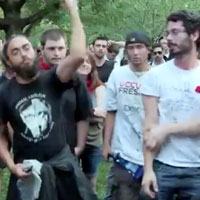 In the era of Occupy-evicted, the movement has emphasized national reunions to stay connected, such as the anti-NATO protests in Chicago, for which Occupiers were bused in from around the country. This nationalization process culminated in the Occupy National Gathering, June 30—July 4 in Philadelphia. Three Occupy Caravans traveled across the country in the three weeks leading up to “NatGat,” bearing activists from San Diego, Tucson, Wichita, Atlanta, Boston, and many other cities. Roughly 1,000 Occupiers attended the gathering’s marches, workshops (with speakers like Chris Hedges and organizer Lisa Fithian), and theatrical protest (like a 99 Percent versus Tax Dodgers baseball game). The event concluded with the daylong production of a Vision for a Democratic Future, listing the attributes of a society that those at NatGat wanted to see.
In the era of Occupy-evicted, the movement has emphasized national reunions to stay connected, such as the anti-NATO protests in Chicago, for which Occupiers were bused in from around the country. This nationalization process culminated in the Occupy National Gathering, June 30—July 4 in Philadelphia. Three Occupy Caravans traveled across the country in the three weeks leading up to “NatGat,” bearing activists from San Diego, Tucson, Wichita, Atlanta, Boston, and many other cities. Roughly 1,000 Occupiers attended the gathering’s marches, workshops (with speakers like Chris Hedges and organizer Lisa Fithian), and theatrical protest (like a 99 Percent versus Tax Dodgers baseball game). The event concluded with the daylong production of a Vision for a Democratic Future, listing the attributes of a society that those at NatGat wanted to see.
Despite many positives, the five-day gathering was rife with contention. Some Occupiers rejected the concept of NatGat outright, feeling that a movement geared towards autonomous action should not be centralizing around a national banner. In this vein, a group of Philadelphia anarchists organized a Radical Convergence the same weekend intended “for those who have felt Occupy in its current form demonizes and excludes radical dialogue, strategy, and action.” Over the five days, these theoretical divides became manifest around issues like “step up, step back,” the goals of the movement, and tactics of confrontation.
The heavy police presence, which included officers from the Philadelphia Police Department, the National Park Service, and the Department of Homeland Security, intensified the divisions around Occupy’s relationship with the police. On June 30, Occupiers were prevented from laying down any “bedding material” at the National Historic Park near Independence Mall. In defiance, a group encircled a tent and locked arms, resulting in a prolonged clash and one arrest for assaulting a federal officer. The aftermath was just as confused — some activists joined hands and hummed “ohm,” while others shouted that the cops were Nazi pigs. An ad-hoc General Assembly to discuss next steps (where they would sleep) fell apart when several Occupiers explained that they did not feel safe discussing strategy while encircled by police. On July 1, twenty-seven protesters were arrested in a nighttime jail solidarity march, raising tensions and anger further.
The mini-documentary attempts to portray the internal conflict over police confrontation at the Occupy National Gathering, particularly as it relates to the future of the movement. Interviews include former Philadelphia Police Captain Ray Lewis, Native American Un-Occupy Albuquerque activist Amalia Montoya, and InterOccupy organizer Tamara Shapiro.
Angry, shocked, overwhelmed? Take action: Support independent media.
We’ve borne witness to a chaotic first few months in Trump’s presidency.
Over the last months, each executive order has delivered shock and bewilderment — a core part of a strategy to make the right-wing turn feel inevitable and overwhelming. But, as organizer Sandra Avalos implored us to remember in Truthout last November, “Together, we are more powerful than Trump.”
Indeed, the Trump administration is pushing through executive orders, but — as we’ve reported at Truthout — many are in legal limbo and face court challenges from unions and civil rights groups. Efforts to quash anti-racist teaching and DEI programs are stalled by education faculty, staff, and students refusing to comply. And communities across the country are coming together to raise the alarm on ICE raids, inform neighbors of their civil rights, and protect each other in moving shows of solidarity.
It will be a long fight ahead. And as nonprofit movement media, Truthout plans to be there documenting and uplifting resistance.
As we undertake this life-sustaining work, we appeal for your support. Please, if you find value in what we do, join our community of sustainers by making a monthly or one-time gift.